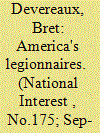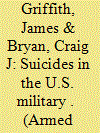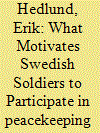|
|
|
Sort Order |
|
|
|
Items / Page
|
|
|
|
|
|
|
| Srl | Item |
| 1 |
ID:
181588


|
|
|
|
|
| Summary/Abstract |
Much like modern defenders of the All-Volunteer Force, the Romans seem to have thought that their professional army could be scaled up in an emergency and that the threat to civilian control could be managed. Neither turned out to be true.
|
|
|
|
|
|
|
|
|
|
|
|
|
|
|
|
| 2 |
ID:
146880


|
|
|
|
|
| Summary/Abstract |
This paper builds a case for examining suicide in the U.S. military relative to broad societal context, specifically, the unique experiences of birth cohorts relating to processes described by Durkheim’s theory of suicide. In more recent birth cohorts, suicide rates have increased among teenagers and young adults. In addition, suicide rates of age intervals at a given time period have been reliably predicted by the size of the birth cohort and the percentage of nonmarital births—supposed indicators of Durkheim’s diminished social integration and behavioral regulation. Consequences of these trends are likely more evident in the U.S. military due to having proportionally more individuals known to be at risk for suicide, that is, young males who are from nontraditional households. The all-volunteer force compared to draft force has fewer applicants to select, and proportionally more of applicants are accepted for military service. Consequently, more recruits having varied conditions now than before, perhaps including greater vulnerability to suicide, serve in the U.S. military. These points are further elaborated with supporting evidence, concluding with a call for new directions in suicide research, practice, and policy.
|
|
|
|
|
|
|
|
|
|
|
|
|
|
|
|
| 3 |
ID:
144150


|
|
|
|
|
| Summary/Abstract |
Walter Y. Oi died in late 2013 at the age of 84. Despite the fact that he was effectively blind since the 4th grade, he became a major contributor to the discipline of Economics and to public policy. An important public policy issue in the late 1960s and early 1970s was the military draft. Legislation to create a volunteer force was signed on 28 September 1971, and conscription was terminated on 30 June 1973. We discuss the key roles that Oi played in the termination of conscription and the subsequent implementation of a volunteer force, and we highlight his contributions to the discipline of Economics.
|
|
|
|
|
|
|
|
|
|
|
|
|
|
|
|
| 4 |
ID:
101328


|
|
|
|
|
| Publication |
2011.
|
| Summary/Abstract |
During the last ten years, the Swedish Armed Forces has undergone a transformation in its shift toward worldwide peacekeeping operations. Subsequently, the Swedish government is moving away from conscription to an all-voluntary recruitment system. This transition may lead to substantial challenges in recruiting new soldiers for the Armed Forces as well as for peacekeeping operations. A key to successful recruitment is understanding what motivates young men and women to participate in peacekeeping operations. This research note addresses questions about what motivated Swedish peacekeeping soldiers to join the 5th mission to Liberia and the 14th mission to Kosovo in 2006. Fabrizio Battistelli's motivation typology, paleomodern, modern, and postmodern, is used in the analysis. The results show that all three motives were represented but that postmodern motives were by far the most common motivator.
|
|
|
|
|
|
|
|
|
|
|
|
|
|
|
|
| 5 |
ID:
101332


|
|
|
|
|
| Publication |
2011.
|
| Summary/Abstract |
During the last ten years, the Swedish Armed Forces has undergone a transformation in its shift toward worldwide peacekeeping operations. Subsequently, the Swedish government is moving away from conscription to an all-voluntary recruitment system. This transition may lead to substantial challenges in recruiting new soldiers for the Armed Forces as well as for peacekeeping operations. A key to successful recruitment is understanding what motivates young men and women to participate in peacekeeping operations. This research note addresses questions about what motivated Swedish peacekeeping soldiers to join the 5th mission to Liberia and the 14th mission to Kosovo in 2006. Fabrizio Battistelli's motivation typology, paleomodern, modern, and postmodern, is used in the analysis. The results show that all three motives were represented but that postmodern motives were by far the most common motivator.
|
|
|
|
|
|
|
|
|
|
|
|
|
|
|
|
|
|
|
|
|